Introduction
This is a compare & contrast review of these two 1/72-scale AMX
30 model kits. This review will compare the two models so as to help
a fellow modeler make a wise choice, and give some tips on building
and detailing.
A Look At The Box Art: What
Is Supposed To Be Inside.
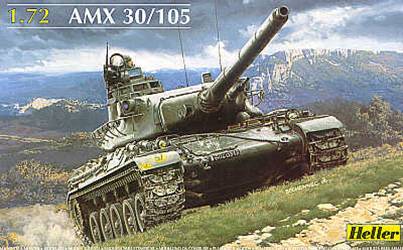
Heller released their kit with at least three different drawings as
box art, this I believe is the latest release. I find the box art
by itself is superbly done and attractive. Atop the turret we see
the commander’s cupola ringed with periscopes and with a light
machine gun and a spotlight. On each turret side are coincident optical
rangefinders similar to that on the M47 and the Panther Ausf. F tanks.
Below the rangefinders are stowage racks. The French 105 mm (4.1 in)
L/56 Modèle F1 tank gun has a thermal sleeve around it. To
the right of the main gun is a coaxial heavy machine gun. To the left
is the gun sight with a small open door. The AMX 30 appears to be
painted in an overall olive color. The license plate with the tricolor
flag indicates an AMX 30 in French service. It would be great if the
kit in the box was as nice and as accurate as this box art.
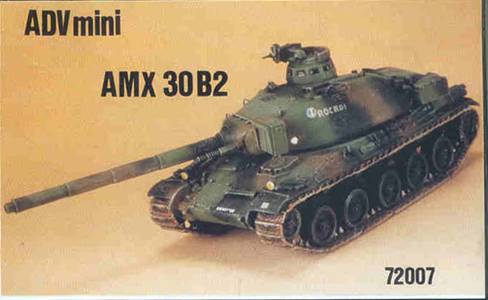
ADVmini’s box art shows
an actual photo of the completed AMX 30B2 tank model completed in
a three-tone French pattern. The main gun appears the same as that
in the Heller kit, but now with a coaxial 20-mm cannon. Like in the
Heller box art the vehicle has metal tracks with rubber pads. There
is a larger storage box on the rear of the turret than Heller’s
AMX 30. The turret no longer has the optical rangefinders on the sides.
There is no stowage rack on the turret sides.
Vehicle History For The Modeler
In the late 1950’s the French, Germans and Italian governments
worked together to develop a new Main Battle Tank (MBT) to replace
their M47’s. The idea was that Germany and France would develop
prototypes and the three nations would all adopt the most successful
prototype. As life and plans so often turn out, the Germans adopted
their own Leopard 1 armed with the British 105-mm L7 rifled gun, the
Italians adopted the US L7 armed M60A1 MBT and later the Leopard 1.
The French adopted their own AMX-30 in 1967 armed with their own 105-mm
gun.
AMX 30 is recognized as being well armed but is very thin skinned
for a MBT, with sufficient protection only for small caliber weapons
and shell fragments. It’s unique in having a coaxial 20-mm automatic
gun rather than the typical light machine gun. AMX-30 production ended
in 1993 with 2300 tanks and 1100 support vehicles. The AMX 30 and
its upgraded versions went into service with the following armies:
Chile, Cyprus, France, Greece, Qatar, Saudi Arabia, Spain, United
Arab Emirates and Venezuela, in which colors it can be modeled.
Heller’s AMX 30 can be modeled in the colors of the French and
Spanish armies during the 1960’s and 1970’s. The ADVmini’s
AMX-30B2 tanks are rebuilds or new production AFV’s with improved
fire control, and better NBC protection. AMX 30B2’s also have
what appear to be several variations of laser range finders and the
coincident rangefinder removed. The AMX 30 was produced over 27 years
in several variants. They can be modeled serving in the 1991 Gulf
War with Saudi and Quatari forces. I understand that the French used
no AMX-30’s during the 1991 liberation of Kuwait.

Kit Information
Kit Similarities
The ADV Mini kit is a resin AMX 30B2 variant that appears largely
based on the old injection-molded styrene Heller kit. The turret,
wheels, and hull therefore have the same dimensions and many of
the same surface details such as: the loader’s hatches, main
gun with thermal sleeve and the wheels. Both models come with hatches
molded closed. Both kits are missing the turret stowage racks, which
is a serious omission.
Kit Differences
In quality of features, Heller shows it age in good but not great
molding. There are little flash and sinkholes but the features are
a little soft. ADV Mini’s kit is top notch, with crisp molding
with little or no flash. For example, the spare track links on the
side of the Heller hull are poor representations of spare tracks.
The spare tracks molded onto the side of the ADV Mini model are
superbly done and look like spare tracks.
The Heller 1/72 scale model has a hollow turret and hull so the
hatches could be cut open and crew figures added and an interior
scratchbuilt. The ADV Mini 1/72 scale hull and turret are solid
and opening up the hatches will be much work. Though more difficult
to work with, the resin ADV Mini kit comes with a lot of the excellent
surface details molded on so there are fewer parts to assemble.
The Heller model’s greatest problem in need of upgrading are
the tracks. As seen in the scan, they are two simple plastic strips
with lines running across and no resemblance to actual AMX 30 tank
tracks, let alone the AMX-30 tracks. In contrast, the ADV Mini AMX
30 tracks are superbly detailed and accurate resin with guide teeth
and surface detail on both sides. Coming in short runs of five links
each, they will be more challenging to work with.
The roadwheels are essentially the same except for the medium of
styrene with the Heller and resin with the ADV Mini kit. Heller’s
drive sprocket is made with no teeth reflecting the simple track
band. If we replace the tracks we’ll need better sprockets
as well. ADV Mini’s sprocket & idler are commendable with
the track links molded onto the wheel.
A nice example of ADV Mini’s attention to detail is the line
of holes running along the bottom of the thermal sleeve of the gun
barrel (drain holes?).
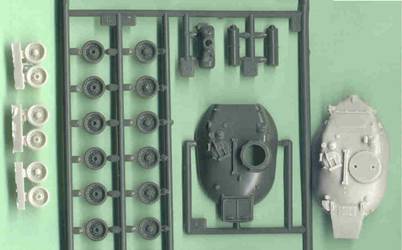
Comparison of the Heller
roadwheels and turret parts with the resin ADV Mini parts. The ADVmini
kits have the same proportions and many of the same details but
have new features of the upgraded AMX 30B2 tank such as the larger
turret bin and no rangefinders.
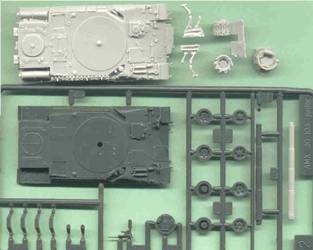
In this photo we have the
pale gray resin AMX 30B2 hull at upper left showing much of the
same molded-on details with the additional details of the upgraded
variant. The molded-on spare tracks have been notably improved.
The gun barrels for both kits, at far right, are largely the same.

In the above photo we can compare
the black color band tracks coming with the Heller model with the
light tan-color resin track sections from ADV Mini, at the bottom
of the scan. The Heller tracks have a poor resemblance to what the
tracks should look like. A nice touch of the ADVmini kit is the
sprocket and idler wheels with track links molded around and onto
the wheels making assembling the tracks so much easier. When I built
these kits in 2003 I was not aware of any aftermarket replacement
tracks like those that are available
now in 2012. (For instance, the ADV
Mini set.)

On the ADV Mini turret
above the holes for the turret basket has been marked out and will
later be drilled to accept the brass wire. This was also done for
the Heller turret. Here we see the assembly of the roadwheel bogies;
apparently the AMX 30 does not have torsion bar suspension common
to so many other contemporary tanks. On each side of the gun mantlet
are boxes which I understand hold a laser rangefinder and searchlight.
This is a good view of the molded-on muffler and tools.
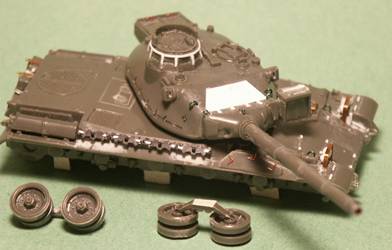
In the above partially assembled
Heller model we can see the significant detailing to make it into
a presentable display model, including new spare tracks on the hull
side, new scratchbuilt headlights and guards, wire lift rings on
the turret, and other small details. Holes to mount a scratchbuilt
turret stowage basket are visible.
Kit Instructions
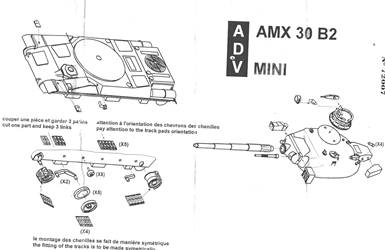
The ADV Mini instructions for their
AMX 20B2 kit are the simple, one page, exploded-view type. Like most
1/72 – 1/76 scale resin models the instructions could be more
complete, though these are better than in many resin kits.
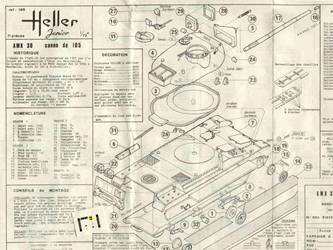
Above is an excerpt of the
old Heller kit’s instructions and the kit decals in the lower
left. I would prefer the instructions be separated into several progressive
steps.
Both model kits have exploded-view
line drawings instructions for assembly and appear about equal in
clearness. They are equally lacking in clearness as well. The Heller
instructions are more complex as it has more parts. My set of Heller
instructions is from an old printing. I hope Heller’s recent
re-release has better instructions. The ADV Mini instructions are
simpler as many of the smaller parts are molded onto the hull and
turret. They are perhaps too simple as the placement of some parts
is not clear.
Assembly Tips
- In the photos of the partially
completed models we can see the added details in brass and styrene.
The Heller model needed more detailing to bring it up to a good
display model. I refer you to the not-too-plentiful photos on the
web and reference books for particular details.
- The turret baskets were produced
using soft copper wire for the vertical bars and stiffer brass wire
for the long horizontal rods which were inserted into holes drilled
into the turret sides. Stowage like boxes, bedrolls and camouflage
netting are common in all the reference photos of the AMX 30 in
action.
- Brass wire grab handles were added
to the rear turret bins.
- The Heller kit had its poor molded-on
headlights cut off and rebuilt from scratch. Headlight guards were
made from brass strips for both models.
- The Heller model needs better smoke
discharges. I stole mine from extras in the Revell T-80BV tank kit.
- Wiring was added to the large square
IR searchlight on both models.
- Resin track sections taken from
the ADV model replaced the insufficient Heller tracks. As my Heller
desert variant has sand skirts, I dispensed with the top run of.
The ADV resin tracks were not easy to work with and make the ADV
model not ideal for a novice.
- The Heller kit needed some sort
of protective sheets or plates behind and on the sides of the mantlet
(see reference photos to see what I mean). These can be produced
from paper or thin aluminum.
- The Heller commander’s cupola
had filets of styrene added around the periscope lenses to increase
the depth. Periscope lenses for both models were simulated with
exposed camera film which is easy to cut and has a good, dark, shiny
surface.
- The poor spare track links attached
to the Heller kit’s right hull side were cut and sanded off.
More accurate replacement track links were taken from my spares
box (PST T-55 track links I believe).
- On the muffler exhaust outlet are
supposed to be hinged covers that come down apparently to keep out
water when submerged. These covers can be simply made with styrene
discs.
Markings
Though vehicle markings are displayed in a box art photo of the completed
ADV Mini AMX 30B2 model, no markings are included. ADV’s box
art is their paint guide for a tri-color olive, black and tan color
camouflage.
My AMX 30B2 was completed in three-tone French camouflage, similar
to the NATO camouflage of the same time period. The model was given
a coat of field green, a point wash added in the recesses and around
high points, then a lighter coat of green added to blend the dark
wash into the color (this helps add depth and makes dry-brushing less
necessary). Over this was applied a light brown and dark gray pattern.
Markings were borrowed from the Heller AMX 30 kit, and the
Extra Tech M10 kit.
Heller’s AMX-30 comes with water slide decals for one French
vehicle [visible in the lower left corner of the kit instructions
scan]. This early version of the AMX 30 may also be modeled in the
markings of Spain, Greece, Venezuela or Chile. Heller’s painting
instructions are a simple olive green. My Heller model was converted
to a Saudi Gulf War 1 AMX 30S tank in a simple desert tan. Over a
base coat of tan was applied a point wash of dark brown and black,
then a lighter shade of tan to blend the wash in and add depth. Nowhere
could I locate clear markings for an Arab, Gulf War AMX 30S so a chevron
on the sideskirt was chosen, which I believe, was a standard marking
for the Coalition in 1991.
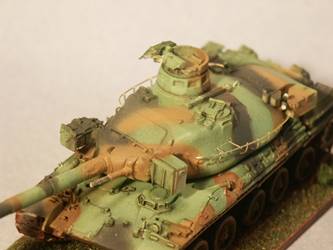
The partially painted ADV
Mini model with a turret basket made from brass and copper wire.
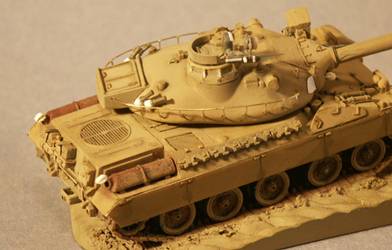
The partially assembled and
painted Heller AMX 30S in desert paint scheme and another view of
the scratchbuilt wire turret basket, smoke dischargers from a Revell
T-80 model, scratchbuilt headlights, and sand skirts from styrene
sheet. The dark cupola periscope lenses have not been added yet. The
exhaust muffler caps and other unpainted details are also visible.
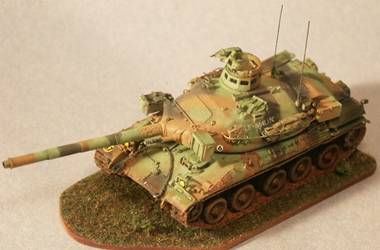
Left side of the completed
AMX 30B2 with added stowage in a northern European camouflage pattern
and a base made from thick styrene sheet and model railroad grass.
Note the lack of stereoscopic rangefinder bulges on the turret sides,
an identifying feature of late AMX 30’s variants. Radio antennas
for both models were simulated using plastic paint-brush bristles.
The periscope lenses made from exposed camera film have been installed
with white glue.
Conclusions
This is my first ADV Mini model and I am quite impressed by the quality.
With the ADV Mini and AlBy companies, France has a lot to be proud
of in the small scale modeling business. The ADV Mini AMX 30B2 kit
I recommend for intermediate and advanced modelers. The Heller AMX
30 makes a great wargaming piece and a modeler of intermediate and
advanced level should be able to make it into a fine display model.
The resin AMX 30B2 can be easily converted to a desert variant with
sand skirts and a few other changes. An interesting option for a conversion
is the AMX 30B2 Brennus, which has ERA blocks over the bow and turret.
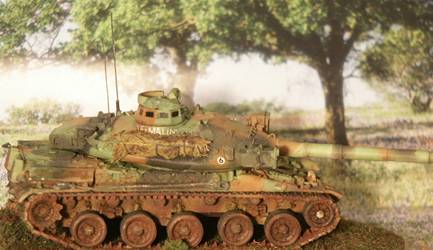
The substitute tracks I used
for the Heller kit were stolen from another model so had to unfortunately
mask the incorrect track links with mud; please forgive me. The track
teeth were scratchbuilt from styrene and glued on.
AMX 30 References
As yet I have not found any suitable reference books on the AMX 30
though there is just enough on the web. Good photographic references
can be found at:
http://www.army-guide.com/eng/product146.html
http://www.globalsecurity.org/military/world/europe/amx-30.htm
_thn.jpg) 
|